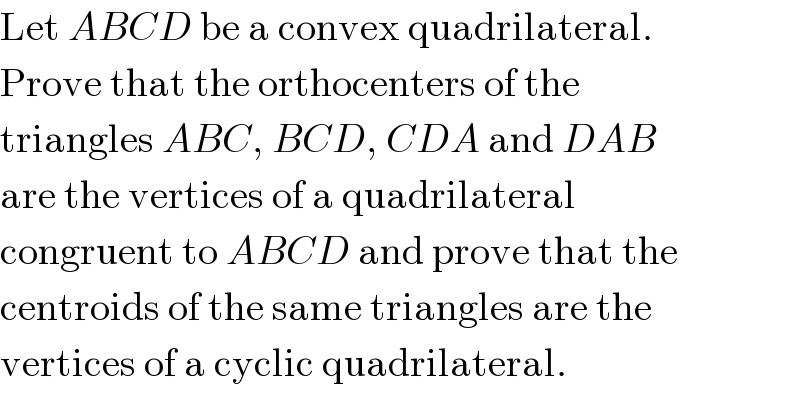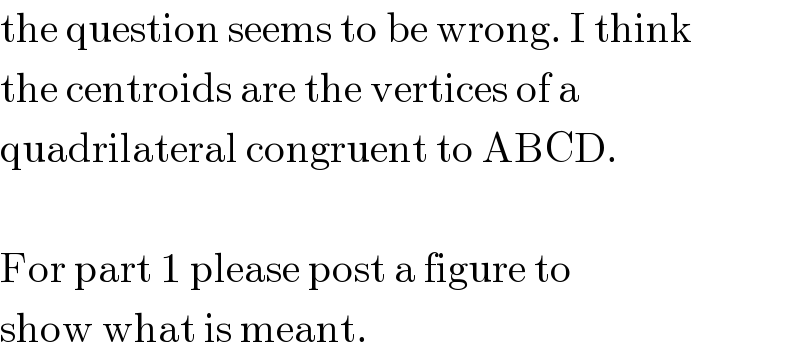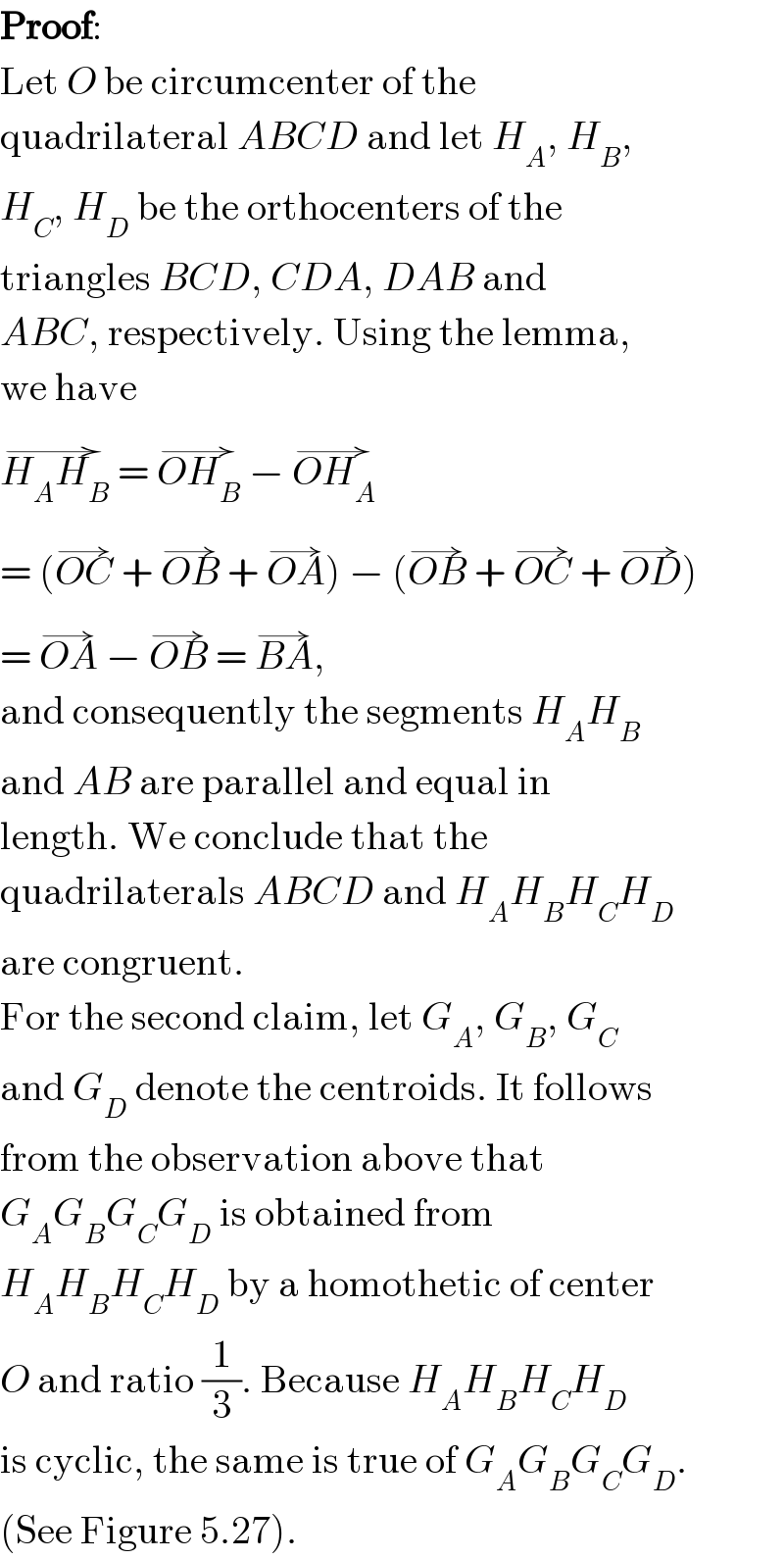
Question Number 16072 by Tinkutara last updated on 17/Jun/17

$$\mathrm{Let}\:{ABCD}\:\mathrm{be}\:\mathrm{a}\:\mathrm{convex}\:\mathrm{quadrilateral}. \\ $$$$\mathrm{Prove}\:\mathrm{that}\:\mathrm{the}\:\mathrm{orthocenters}\:\mathrm{of}\:\mathrm{the} \\ $$$$\mathrm{triangles}\:{ABC},\:{BCD},\:{CDA}\:\mathrm{and}\:{DAB} \\ $$$$\mathrm{are}\:\mathrm{the}\:\mathrm{vertices}\:\mathrm{of}\:\mathrm{a}\:\mathrm{quadrilateral} \\ $$$$\mathrm{congruent}\:\mathrm{to}\:{ABCD}\:\mathrm{and}\:\mathrm{prove}\:\mathrm{that}\:\mathrm{the} \\ $$$$\mathrm{centroids}\:\mathrm{of}\:\mathrm{the}\:\mathrm{same}\:\mathrm{triangles}\:\mathrm{are}\:\mathrm{the} \\ $$$$\mathrm{vertices}\:\mathrm{of}\:\mathrm{a}\:\mathrm{cyclic}\:\mathrm{quadrilateral}. \\ $$
Commented by mrW1 last updated on 06/Jul/17

$$\mathrm{the}\:\mathrm{question}\:\mathrm{seems}\:\mathrm{to}\:\mathrm{be}\:\mathrm{wrong}.\:\mathrm{I}\:\mathrm{think} \\ $$$$\mathrm{the}\:\mathrm{centroids}\:\mathrm{are}\:\mathrm{the}\:\mathrm{vertices}\:\mathrm{of}\:\mathrm{a} \\ $$$$\mathrm{quadrilateral}\:\mathrm{congruent}\:\mathrm{to}\:\mathrm{ABCD}. \\ $$$$ \\ $$$$\mathrm{For}\:\mathrm{part}\:\mathrm{1}\:\mathrm{please}\:\mathrm{post}\:\mathrm{a}\:\mathrm{figure}\:\mathrm{to} \\ $$$$\mathrm{show}\:\mathrm{what}\:\mathrm{is}\:\mathrm{meant}. \\ $$
Commented by mrW1 last updated on 06/Jul/17

$$\mathrm{yes}\:\mathrm{please}. \\ $$
Commented by mrW1 last updated on 06/Jul/17

$$\mathrm{I}\:\mathrm{can}\:\mathrm{prove}\:\mathrm{that}\:\mathrm{the}\:\mathrm{centroids}\:\mathrm{are}\:\mathrm{the}\:\mathrm{vertices}\:\mathrm{of}\:\mathrm{a} \\ $$$$\mathrm{quadrilateral}\:\mathrm{congruent}\:\mathrm{to}\:\mathrm{ABCD}.\:\mathrm{Its} \\ $$$$\mathrm{area}\:\mathrm{is}\:\frac{\mathrm{1}}{\mathrm{9}}\:\mathrm{of}\:\mathrm{the}\:\mathrm{area}\:\mathrm{of}\:\mathrm{ABCD}. \\ $$
Answered by Tinkutara last updated on 07/Jul/17

Commented by Tinkutara last updated on 07/Jul/17

$$\boldsymbol{\mathrm{Lemma}}\:\boldsymbol{\mathrm{used}}: \\ $$$$\overset{\rightarrow} {{OA}}\:+\:\overset{\rightarrow} {{OB}}\:+\:\overset{\rightarrow} {{OC}}\:=\:\overset{\rightarrow} {{OH}}\:\mathrm{and} \\ $$$$\overset{\rightarrow} {{OH}}\:=\:\mathrm{3}\overset{\rightarrow} {{OG}}. \\ $$
Commented by Tinkutara last updated on 07/Jul/17

$$\boldsymbol{\mathrm{Proof}}: \\ $$$$\mathrm{Let}\:{O}\:\mathrm{be}\:\mathrm{circumcenter}\:\mathrm{of}\:\mathrm{the} \\ $$$$\mathrm{quadrilateral}\:{ABCD}\:\mathrm{and}\:\mathrm{let}\:{H}_{{A}} ,\:{H}_{{B}} , \\ $$$${H}_{{C}} ,\:{H}_{{D}} \:\mathrm{be}\:\mathrm{the}\:\mathrm{orthocenters}\:\mathrm{of}\:\mathrm{the} \\ $$$$\mathrm{triangles}\:{BCD},\:{CDA},\:{DAB}\:\mathrm{and} \\ $$$${ABC},\:\mathrm{respectively}.\:\mathrm{Using}\:\mathrm{the}\:\mathrm{lemma}, \\ $$$$\mathrm{we}\:\mathrm{have} \\ $$$$\overset{\rightarrow} {{H}_{{A}} {H}_{{B}} }\:=\:\overset{\rightarrow} {{OH}_{{B}} }\:−\:\overset{\rightarrow} {{OH}_{{A}} } \\ $$$$=\:\left(\overset{\rightarrow} {{OC}}\:+\:\overset{\rightarrow} {{OB}}\:+\:\overset{\rightarrow} {{OA}}\right)\:−\:\left(\overset{\rightarrow} {{OB}}\:+\:\overset{\rightarrow} {{OC}}\:+\:\overset{\rightarrow} {{OD}}\right) \\ $$$$=\:\overset{\rightarrow} {{OA}}\:−\:\overset{\rightarrow} {{OB}}\:=\:\overset{\rightarrow} {{BA}}, \\ $$$$\mathrm{and}\:\mathrm{consequently}\:\mathrm{the}\:\mathrm{segments}\:{H}_{{A}} {H}_{{B}} \\ $$$$\mathrm{and}\:{AB}\:\mathrm{are}\:\mathrm{parallel}\:\mathrm{and}\:\mathrm{equal}\:\mathrm{in} \\ $$$$\mathrm{length}.\:\mathrm{We}\:\mathrm{conclude}\:\mathrm{that}\:\mathrm{the} \\ $$$$\mathrm{quadrilaterals}\:{ABCD}\:\mathrm{and}\:{H}_{{A}} {H}_{{B}} {H}_{{C}} {H}_{{D}} \\ $$$$\mathrm{are}\:\mathrm{congruent}. \\ $$$$\mathrm{For}\:\mathrm{the}\:\mathrm{second}\:\mathrm{claim},\:\mathrm{let}\:{G}_{{A}} ,\:{G}_{{B}} ,\:{G}_{{C}} \\ $$$$\mathrm{and}\:{G}_{{D}} \:\mathrm{denote}\:\mathrm{the}\:\mathrm{centroids}.\:\mathrm{It}\:\mathrm{follows} \\ $$$$\mathrm{from}\:\mathrm{the}\:\mathrm{observation}\:\mathrm{above}\:\mathrm{that} \\ $$$${G}_{{A}} {G}_{{B}} {G}_{{C}} {G}_{{D}} \:\mathrm{is}\:\mathrm{obtained}\:\mathrm{from} \\ $$$${H}_{{A}} {H}_{{B}} {H}_{{C}} {H}_{{D}} \:\mathrm{by}\:\mathrm{a}\:\mathrm{homothetic}\:\mathrm{of}\:\mathrm{center} \\ $$$${O}\:\mathrm{and}\:\mathrm{ratio}\:\frac{\mathrm{1}}{\mathrm{3}}.\:\mathrm{Because}\:{H}_{{A}} {H}_{{B}} {H}_{{C}} {H}_{{D}} \\ $$$$\mathrm{is}\:\mathrm{cyclic},\:\mathrm{the}\:\mathrm{same}\:\mathrm{is}\:\mathrm{true}\:\mathrm{of}\:{G}_{{A}} {G}_{{B}} {G}_{{C}} {G}_{{D}} . \\ $$$$\left(\mathrm{See}\:\mathrm{Figure}\:\mathrm{5}.\mathrm{27}\right). \\ $$
Commented by Tinkutara last updated on 07/Jul/17

Commented by mrW1 last updated on 07/Jul/17

$$\mathrm{the}\:\mathrm{question}\:\mathrm{didn}'\mathrm{t}\:\mathrm{say}\:\mathrm{that}\:\mathrm{ABCD}\:\mathrm{is} \\ $$$$\mathrm{cyclic}. \\ $$
Commented by mrW1 last updated on 07/Jul/17

$$\mathrm{the}\:\mathrm{answer}\:\mathrm{given}\:\mathrm{doesn}'\mathrm{t}\:\mathrm{match}\:\mathrm{the} \\ $$$$\mathrm{question}.\:\mathrm{i}\:\mathrm{can}\:\mathrm{not}\:\mathrm{understand}. \\ $$
Commented by mrW1 last updated on 07/Jul/17

$$\mathrm{i}\:\mathrm{have}\:\mathrm{said}\:\mathrm{the}\:\mathrm{question}\:\mathrm{is}\:\mathrm{not}\:\mathrm{correct}. \\ $$$$\mathrm{so}\:\mathrm{i}\:\mathrm{can}\:\mathrm{not}\:\mathrm{give}\:\mathrm{a}\:\mathrm{solution}\:\mathrm{to}\:\mathrm{it}.\: \\ $$$$\mathrm{the}\:\mathrm{proof}\:\mathrm{i}\:\mathrm{meant}\:\mathrm{is}\:\mathrm{following}.\:\mathrm{but}\:\mathrm{it} \\ $$$$\mathrm{is}\:\mathrm{not}\:\mathrm{the}\:\mathrm{proof}\:\mathrm{to}\:\mathrm{your}\:\mathrm{question}\:\mathrm{exactly}. \\ $$
Commented by mrW1 last updated on 07/Jul/17

Commented by mrW1 last updated on 07/Jul/17
![ABCD is an any convex quadrilateral. K,L,M,N are the centroids described. ((GM)/(GB))=(1/3) ((GN)/(GC))=(1/3) ⇒MN//BC and MN=((BC)/3) similarly NL//AB and NL=((AB)/3) LK//AD and LK=((AD)/3) KM//DC and KM=((DC)/3) ⇒LKNM is congruent to ABCD ⇒Area [KLNM]=(1/9) Area [ABCD]](Q17563.png)
$$\mathrm{ABCD}\:\mathrm{is}\:\mathrm{an}\:\mathrm{any}\:\mathrm{convex}\:\mathrm{quadrilateral}. \\ $$$$\mathrm{K},\mathrm{L},\mathrm{M},\mathrm{N}\:\mathrm{are}\:\mathrm{the}\:\mathrm{centroids}\:\mathrm{described}. \\ $$$$\frac{\mathrm{GM}}{\mathrm{GB}}=\frac{\mathrm{1}}{\mathrm{3}} \\ $$$$\frac{\mathrm{GN}}{\mathrm{GC}}=\frac{\mathrm{1}}{\mathrm{3}} \\ $$$$\Rightarrow\mathrm{MN}//\mathrm{BC}\:\mathrm{and}\:\mathrm{MN}=\frac{\mathrm{BC}}{\mathrm{3}} \\ $$$$\mathrm{similarly} \\ $$$$\mathrm{NL}//\mathrm{AB}\:\mathrm{and}\:\mathrm{NL}=\frac{\mathrm{AB}}{\mathrm{3}} \\ $$$$\mathrm{LK}//\mathrm{AD}\:\mathrm{and}\:\mathrm{LK}=\frac{\mathrm{AD}}{\mathrm{3}} \\ $$$$\mathrm{KM}//\mathrm{DC}\:\mathrm{and}\:\mathrm{KM}=\frac{\mathrm{DC}}{\mathrm{3}} \\ $$$$\Rightarrow\mathrm{LKNM}\:\mathrm{is}\:\mathrm{congruent}\:\mathrm{to}\:\mathrm{ABCD} \\ $$$$\Rightarrow\mathrm{Area}\:\left[\mathrm{KLNM}\right]=\frac{\mathrm{1}}{\mathrm{9}}\:\mathrm{Area}\:\left[\mathrm{ABCD}\right] \\ $$
Commented by mrW1 last updated on 07/Jul/17

$$\mathrm{this}\:\mathrm{proof}\:\mathrm{is}\:\mathrm{better}\:\mathrm{than}\:\mathrm{that}\:\mathrm{given}\:\mathrm{in} \\ $$$$\mathrm{your}\:\mathrm{book},\:\mathrm{i}\:\mathrm{think}. \\ $$$$\mathrm{ABCD}\:\mathrm{must}\:\mathrm{not}\:\mathrm{be}\:\mathrm{cyclic}! \\ $$
Commented by Tinkutara last updated on 08/Jul/17

$$\mathrm{Thanks}\:\mathrm{Sir}! \\ $$
